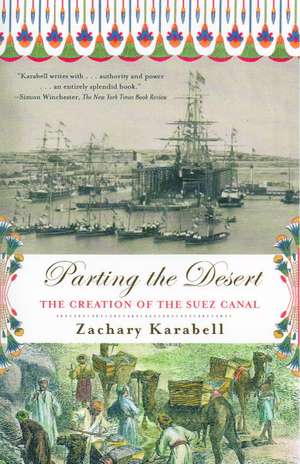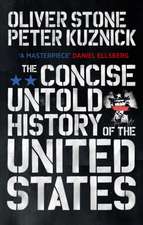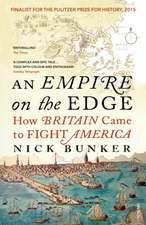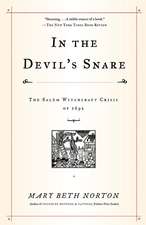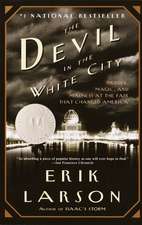Parting the Desert: The Creation of the Suez Canal
Autor Zachary Karabellen Limba Engleză Paperback – 30 apr 2004
The dream was a waterway that would unite the East and the West, and the ambitious, energetic French diplomat and entrepreneur Ferdinand de Lesseps was the mastermind behind the project. Lesseps saw the project through fifteen years of financial challenges, technical obstacles, and political intrigues. He convinced ordinary French citizens to invest their money, and he won the backing of Napoleon III and of Egypt's prince Muhammad Said. But the triumph was far from perfect: the construction relied heavily on forced labor and technical and diplomatic obstacles constantly threatened completion. The inauguration in 1869 captured the imagination of the world. The Suez Canal was heralded as a symbol of progress that would unite nations, but its legacy is mixed. Parting the Desert is both a transporting narrative and a meditation on the origins of the modern Middle East.
Preț: 115.42 lei
Nou
Puncte Express: 173
Preț estimativ în valută:
22.09€ • 22.98$ • 18.24£
22.09€ • 22.98$ • 18.24£
Carte disponibilă
Livrare economică 25 martie-08 aprilie
Preluare comenzi: 021 569.72.76
Specificații
ISBN-13: 9780375708121
ISBN-10: 037570812X
Pagini: 320
Ilustrații: 16 PP B&W
Dimensiuni: 132 x 202 x 22 mm
Greutate: 0.31 kg
Editura: Vintage Publishing
ISBN-10: 037570812X
Pagini: 320
Ilustrații: 16 PP B&W
Dimensiuni: 132 x 202 x 22 mm
Greutate: 0.31 kg
Editura: Vintage Publishing
Notă biografică
Zachary Karabell was educated at Columbia; Oxford, where he received a degree in Modern Middle Eastern Studies; and Havard, where he received his Ph.D. in 1996. He has taught at Harvard, the University of Massachusetts at Boston, and Dartmouth. He is the author of several books, including The Last Campaign: How Harry Truman Won the 1948 Election, which won the Chicago Tribune Heartland prize. His essays and reviews have appeared in various publications, such as The New York Times, the Los Angeles Times, Foreign Policy, and Newsweek. He lives in New York City.
Extras
Chapter 1
The Twilight
It was late afternoon in the desert when they emerged from the labyrinth of eddies that flowed through the Nile Delta. The breeze carried the trace of salt from the Mediterranean, and though the wind was less harsh than it had been several weeks before, the area was still desolate. The day had been warm; the night promised bitter cold, but at least they had finally arrived at their destination on the coast, where the easternmost branch of the Nile used to meet the Mediterranean Sea. Pitching their tents, Ferdinand de Lesseps and his companions settled in for the evening.
They had sailed from Damietta, where St. Louis died centuries before in a fool's errand of a crusade, and where much later Napoleon's troops stumbled on the Rosetta Stone. They had crossed Lake Manzala, in four fishing boats outfitted with small cabins to shelter them at night. And then they camped on the thin littoral separating the brackish lake from the waters of the Mediterranean. They were not there to explore. They were there to begin.
At dawn on April 25, 1859, they packed their camels and hurried to their destination, where they were joined by a group of Egyptian laborers. There were 150 altogether, diplomats, businessmen, engineers, and peasants. Their silhouettes moved across the sunrise, and over each shoulder there was a pickax.
At a spot known only to him, Lesseps raised his hand and ordered the company to halt. They unloaded their gear and stood, picks in hand, waiting. Lesseps looked toward the sea and then back toward the desert. His compact energy conveyed a surprising vigor for a fifty-three-year-old widowed former bureaucrat. His eyes set, his mustache elegantly trimmed, he was at a pivotal point in his life, and he knew it.
It was an act of theater, carefully staged. No official representatives of any government attended the ceremony, and the story of what happened was disseminated only by Lesseps himself. He unfurled an Egyptian flag and planted it in the ground, yet there was something furtive about the whole endeavor. He had sought but not formally received the blessing of the ruler of Egypt. He decided to proceed anyway. He paused for a moment, not just because he was taking a risk, but because he was about to change the political landscape of three continents, because he was embarking on an adventure that would alter the terrain of the planet. Then he spoke.
"In the name of the Universal Company of the Maritime Suez Canal, we are about to commence this work, which will open up the East to the commerce and civilization of the West. . . . The thorough surveys that we have done give us the confidence that the enterprise that commences today will not only be a work of progress, but will return immense rewards to those who have striven to make it real." He told the group to lift up their axes. "Remember," he continued, "you are not simply digging up soil. Your work will bring prosperity to your families and to your countries." Then he asked one of the workers to hand him an ax. Shouting, "In honor of the viceroy Muhammad Said Pasha," he raised his arm, and 150 arms raised up with him. Row after row of metal picks gleamed in the sun and descended into the earth. The building of the Suez Canal had begun.1
The states of Europe competed over it; the Ottoman Empire tried to prevent its construction; and, later, the armies of the modern Middle East destroyed the cities along its banks. In 1869, the kings and queens of Europe gathered to celebrate its inauguration, for a week of festivities so lavish that even the jaded royalty of Paris, London, and Vienna were awed. It was the triumph of the mid-nineteenth century, a joint venture between the ruler of Egypt and an ambitious Frenchman. Heralded as a symbol of progress, lauded as proof that geography would no longer separate the Orient and the Occident, the East and the West, the Suez Canal was the center of the world.
Today, all that marks its southern point is a pediment encased in graffiti. No statue, not even a memory of the forgotten soldier who once stood there to commemorate Egypt's wars. A few rusting parts of tanks serve as a reminder of the battles fought between Egypt and Israel, but that seems long ago. The day when Gamal Abdel Nasser stood in a square in Alexandria in 1956 and defied the French, the English, and the Americans by nationalizing the canal-even that belongs to another era, when Suez still mattered, when its fate could send the world into panic.
Where fleets once sailed, now there are tankers from third-rank nations. Freighters from Doha and container ships from Monrovia glide past that ruined pediment at the southern tip. They enter or exit the canal in convoy clusters of four or five. On the journey south, they spill out into the azure waters of the Gulf of Suez, where at sunset, the sharp brown cliffs of the Gebel Attaka rise quickly to block the dying rays.
On the journey north, they make the hundred-mile voyage to the Mediterranean Sea in less than a day. They sail through the Bitter Lakes and past the city of Ismailia, until they empty into Lake Manzala and arrive at the terminus of Port Said. There they pass by the headquarters of the Canal Company, a decaying Victorian fantasy of white crenellation and green domes. Nearby is another orphaned stone pedestal, where a statue of Ferdinand de Lesseps once stood. Freighters and tankers pass through a canal bounded not by heroic monuments, but by pockmarked pediments.
The canal was built by the sweat of hundreds of thousands, but it was Lesseps's child-his, and that of the rulers of Egypt, Said and Ismail. Lesseps, a French diplomat who worshiped at the altar of progress; Muhammad Said, the Egyptian viceroy who saw in France and England all that his country could be but wasn't; and Ismail, his successor, who tried to purchase a better future for Egypt using European loans. Lesseps saw his vision vindicated. Said and Ismail died before realizing that theirs would not be. But decades later, enraged at the lost promise of the canal, their great-grandchildren seized it for themselves.
In July 1956, Egyptians listened as Nasser claimed the canal for Egypt and believed that after years of disappointment, the future had finally arrived. They thought that the progress promised in the nineteenth century had only been delayed until the twentieth. But their moment of triumph was brief. The British, French, and Israelis attacked, and the city of Port Said was partially destroyed by British jets. Nasser scuttled ships in the canal to prevent its use by Egypt's enemies. A decade later, during the 1967 Arab-Israeli war, all of the cities along the canal were bombarded, this time by Israeli forces on the eastern bank. Ships were scuttled once again; the harbors were mined; and the canal was closed for years. A war of attrition followed, and Ismailia was decimated. In 1973, Suez was a battle zone one more time, when Anwar Sadat ordered his army to cross the canal and confront Israeli troops on the other side.
Today, half a million people live in the reconstructed cities of Suez and Ismailia, and a million in Port Said. The port of Suez has been inhabited since Roman times, but today it is a concrete jungle of prefab apartment blocks, with no trace of anything earlier than the 1970s. Ismailia nestles Lake Timsah, where Moses may or may not have led the people of Israel out of Egypt thirty-five centuries ago. Its shores are now guarded with barbed wire. A few Victorian houses survived the Arab-Israeli wars. The mansion where Lesseps and his family lived still stands. It is a museum filled with bad copies of nineteenth-century furniture and Parisian drapes, closed to the public except on permission from the Suez Canal authorities, which must be obtained in Cairo many days in advance. Port Said, the jewel of the canal, which guards its Mediterranean entrance, is cloaked in pollution. Miles of anonymous buildings give way to petroleum-soaked beaches that seasonally fill with middle-class Egyptians on holiday. The main street is one of the prime shopping centers in the country, but only for a few months each year, when those thousands of vacationers arrive to lie on the shore and watch the ships as they line up to make the journey south.
The canal still makes money for Egypt, but the commerce of the world has found other outlets. When the canal was completed, the journey from Europe to India was sliced from months to weeks, and the arduous route around the Cape of Good Hope was rendered obsolete. The twentieth century reversed the process. Modern tankers and container ships can take the longer route, and the cost is not much different. The trip around the Cape requires more fuel, but the shorter route entails canal dues, and for many companies, it is six of one, half a dozen of the other. Some newer ships are too large for the canal, and the Egyptian government is left with a Sisyphean task: by the time it dredges and widens the channel, the next generation of supertankers will have arrived. The navies of the world take advantage of the canal for reasons of convenience, but outside of Egypt or Israel, Jordan or Saudi Arabia, it is no one's strategic priority.
That was not the future its creators imagined. A vision of progress energized Lesseps, a vision that East and West could be joined, and that the union of the two seas and the two worlds would allow the energies of mankind to flourish as never before. A similar dream animated the rulers of Egypt, the emperor and empress of France, the engineers who designed the canal, and the shareholders who invested in it. In the middle of the nineteenth century, mankind was on the verge of conquering the world. Nature would be harnessed for the betterment of all. Disease and ignorance would be no more. Where superstition and archaic religion had once kept people fearful and timid, science and industry would allow human beings to claim the birthright of Eden.
Ferdinand de Lesseps was a potent combination of vision, pragmatism, and will. Without vision, Lesseps could never have turned a hundred-mile stretch of barely inhabited desert with no source of fresh water into a canal connecting the Mediterranean to the Red Sea. He could not have mobilized the leaders of Egypt, the financial elites of Europe, Napoleon III, and millions of French citizens to support his improbable scheme. He could never have dodged the opposition of the British government and its wily prime minister, Lord Palmerston, or the animosity of the Ottoman sultan and his ministers in Constantinople. Without pragmatism, Lesseps could never have organized a venture that required the largest jetty ever constructed and a decade of labor by tens of thousands of workers. He could not have convinced engineers to design machines to dredge the soil; he could not have set up a company to oversee the excavation of seventy-five million cubic meters of sand; he could not have maneuvered through the diplomatic shoals that constantly loomed. And without will, he could not have fended off others who wanted to claim the idea for themselves.
He was not alone, however. In antiquity, there had been canals linking the Red Sea to the Mediterranean-not direct ones, for the most part, but canals nonetheless, using the Nile to Cairo and a waterway from Cairo to the port of Suez. And when those fell into disuse and silted over, the memory of them remained, kept alive by travelers' tales and by European merchants looking for alternate sea routes that would make them rich and their nations strong.
The idea for the modern canal was born before Lesseps, at a decisive moment in modern Egyptian history, when Napoleon Bonaparte landed outside of Alexandria in 1798. He brought with him not just an army, but a team of scholars charged with studying the country so that the French could make maximal use of its resources. They knew of the old canals and hoped to dig another one, but an erroneous calculation by the leading surveyor set back plans for decades, until a group of engineers, led by a disciple of Henri de Saint-Simon, returned to Egypt thirty-five years later.
If Napoleon reintroduced the idea of a maritime canal, Prosper Enfantin and the Saint-Simonians took it one step closer to fruition. They believed in progress, but even more, they believed that the world had been sundered. Male stood apart from female, religion stood opposed to science, and East was cut off from West. In this duality, said Enfantin, all suffered. The West was advancing, but until it was united with the East, its growth would be stunted. The only way to heal these wounds was to join the two worlds by removing the physical obstacle that separated them, the land bridge of the Isthmus of Suez. Once the canal pierced the sands and the seas were connected, the energies of East and West would flow together. The world would be made whole, and civilization would blossom.
Whatever the virtues of Enfantin's scheme, its metaphysical trappings limited its appeal. He and his followers barely escaped prison on their journey to Egypt, and had it not been for the intervention of the French consul, they might not have fared well in the land of the pharaohs. But although young Ferdinand de Lesseps protected the Saint-Simonians in the 1830s, twenty years later they came to regret his help. Having saved them, he then appropriated their ambition and made it his own. Lesseps was not the first person to seize someone else's idea, but he was surely one of the most successful at it. In later years, his name was immortalized. He was indelibly associated with the canal, and the contribution of Enfantin and the Saint-Simonians was largely forgotten.
But it took more than Lesseps's imagination and the industry of Europe. The Saint-Simonians dreamed of a marriage between East and West, but no matter how eager the West was for this union, without the active assent of the East the marriage could never have been consummated. To make the canal a reality, Lesseps needed the support of the ruler of Egypt, and he found a willing partner in Muhammad Said Pasha.
Said was the son of Muhammad Ali, an Albanian mercenary who rose to power in Egypt in the wake of Napoleon's defeat. He was a fat child, fond of food and disinclined to the manly virtues of exercise and martial prowess. His father was determined to make Said into a man who could practice the arts of war and diplomacy with equal skill, and he entrusted Said to the care of the French consul. The young prince and Lesseps forged a bond, and when Said came to power in 1854, he invited Lesseps to celebrate his new fortune. Hoping to convince Said of the virtues of the canal, Lesseps happily accepted the invitation.
The Twilight
It was late afternoon in the desert when they emerged from the labyrinth of eddies that flowed through the Nile Delta. The breeze carried the trace of salt from the Mediterranean, and though the wind was less harsh than it had been several weeks before, the area was still desolate. The day had been warm; the night promised bitter cold, but at least they had finally arrived at their destination on the coast, where the easternmost branch of the Nile used to meet the Mediterranean Sea. Pitching their tents, Ferdinand de Lesseps and his companions settled in for the evening.
They had sailed from Damietta, where St. Louis died centuries before in a fool's errand of a crusade, and where much later Napoleon's troops stumbled on the Rosetta Stone. They had crossed Lake Manzala, in four fishing boats outfitted with small cabins to shelter them at night. And then they camped on the thin littoral separating the brackish lake from the waters of the Mediterranean. They were not there to explore. They were there to begin.
At dawn on April 25, 1859, they packed their camels and hurried to their destination, where they were joined by a group of Egyptian laborers. There were 150 altogether, diplomats, businessmen, engineers, and peasants. Their silhouettes moved across the sunrise, and over each shoulder there was a pickax.
At a spot known only to him, Lesseps raised his hand and ordered the company to halt. They unloaded their gear and stood, picks in hand, waiting. Lesseps looked toward the sea and then back toward the desert. His compact energy conveyed a surprising vigor for a fifty-three-year-old widowed former bureaucrat. His eyes set, his mustache elegantly trimmed, he was at a pivotal point in his life, and he knew it.
It was an act of theater, carefully staged. No official representatives of any government attended the ceremony, and the story of what happened was disseminated only by Lesseps himself. He unfurled an Egyptian flag and planted it in the ground, yet there was something furtive about the whole endeavor. He had sought but not formally received the blessing of the ruler of Egypt. He decided to proceed anyway. He paused for a moment, not just because he was taking a risk, but because he was about to change the political landscape of three continents, because he was embarking on an adventure that would alter the terrain of the planet. Then he spoke.
"In the name of the Universal Company of the Maritime Suez Canal, we are about to commence this work, which will open up the East to the commerce and civilization of the West. . . . The thorough surveys that we have done give us the confidence that the enterprise that commences today will not only be a work of progress, but will return immense rewards to those who have striven to make it real." He told the group to lift up their axes. "Remember," he continued, "you are not simply digging up soil. Your work will bring prosperity to your families and to your countries." Then he asked one of the workers to hand him an ax. Shouting, "In honor of the viceroy Muhammad Said Pasha," he raised his arm, and 150 arms raised up with him. Row after row of metal picks gleamed in the sun and descended into the earth. The building of the Suez Canal had begun.1
The states of Europe competed over it; the Ottoman Empire tried to prevent its construction; and, later, the armies of the modern Middle East destroyed the cities along its banks. In 1869, the kings and queens of Europe gathered to celebrate its inauguration, for a week of festivities so lavish that even the jaded royalty of Paris, London, and Vienna were awed. It was the triumph of the mid-nineteenth century, a joint venture between the ruler of Egypt and an ambitious Frenchman. Heralded as a symbol of progress, lauded as proof that geography would no longer separate the Orient and the Occident, the East and the West, the Suez Canal was the center of the world.
Today, all that marks its southern point is a pediment encased in graffiti. No statue, not even a memory of the forgotten soldier who once stood there to commemorate Egypt's wars. A few rusting parts of tanks serve as a reminder of the battles fought between Egypt and Israel, but that seems long ago. The day when Gamal Abdel Nasser stood in a square in Alexandria in 1956 and defied the French, the English, and the Americans by nationalizing the canal-even that belongs to another era, when Suez still mattered, when its fate could send the world into panic.
Where fleets once sailed, now there are tankers from third-rank nations. Freighters from Doha and container ships from Monrovia glide past that ruined pediment at the southern tip. They enter or exit the canal in convoy clusters of four or five. On the journey south, they spill out into the azure waters of the Gulf of Suez, where at sunset, the sharp brown cliffs of the Gebel Attaka rise quickly to block the dying rays.
On the journey north, they make the hundred-mile voyage to the Mediterranean Sea in less than a day. They sail through the Bitter Lakes and past the city of Ismailia, until they empty into Lake Manzala and arrive at the terminus of Port Said. There they pass by the headquarters of the Canal Company, a decaying Victorian fantasy of white crenellation and green domes. Nearby is another orphaned stone pedestal, where a statue of Ferdinand de Lesseps once stood. Freighters and tankers pass through a canal bounded not by heroic monuments, but by pockmarked pediments.
The canal was built by the sweat of hundreds of thousands, but it was Lesseps's child-his, and that of the rulers of Egypt, Said and Ismail. Lesseps, a French diplomat who worshiped at the altar of progress; Muhammad Said, the Egyptian viceroy who saw in France and England all that his country could be but wasn't; and Ismail, his successor, who tried to purchase a better future for Egypt using European loans. Lesseps saw his vision vindicated. Said and Ismail died before realizing that theirs would not be. But decades later, enraged at the lost promise of the canal, their great-grandchildren seized it for themselves.
In July 1956, Egyptians listened as Nasser claimed the canal for Egypt and believed that after years of disappointment, the future had finally arrived. They thought that the progress promised in the nineteenth century had only been delayed until the twentieth. But their moment of triumph was brief. The British, French, and Israelis attacked, and the city of Port Said was partially destroyed by British jets. Nasser scuttled ships in the canal to prevent its use by Egypt's enemies. A decade later, during the 1967 Arab-Israeli war, all of the cities along the canal were bombarded, this time by Israeli forces on the eastern bank. Ships were scuttled once again; the harbors were mined; and the canal was closed for years. A war of attrition followed, and Ismailia was decimated. In 1973, Suez was a battle zone one more time, when Anwar Sadat ordered his army to cross the canal and confront Israeli troops on the other side.
Today, half a million people live in the reconstructed cities of Suez and Ismailia, and a million in Port Said. The port of Suez has been inhabited since Roman times, but today it is a concrete jungle of prefab apartment blocks, with no trace of anything earlier than the 1970s. Ismailia nestles Lake Timsah, where Moses may or may not have led the people of Israel out of Egypt thirty-five centuries ago. Its shores are now guarded with barbed wire. A few Victorian houses survived the Arab-Israeli wars. The mansion where Lesseps and his family lived still stands. It is a museum filled with bad copies of nineteenth-century furniture and Parisian drapes, closed to the public except on permission from the Suez Canal authorities, which must be obtained in Cairo many days in advance. Port Said, the jewel of the canal, which guards its Mediterranean entrance, is cloaked in pollution. Miles of anonymous buildings give way to petroleum-soaked beaches that seasonally fill with middle-class Egyptians on holiday. The main street is one of the prime shopping centers in the country, but only for a few months each year, when those thousands of vacationers arrive to lie on the shore and watch the ships as they line up to make the journey south.
The canal still makes money for Egypt, but the commerce of the world has found other outlets. When the canal was completed, the journey from Europe to India was sliced from months to weeks, and the arduous route around the Cape of Good Hope was rendered obsolete. The twentieth century reversed the process. Modern tankers and container ships can take the longer route, and the cost is not much different. The trip around the Cape requires more fuel, but the shorter route entails canal dues, and for many companies, it is six of one, half a dozen of the other. Some newer ships are too large for the canal, and the Egyptian government is left with a Sisyphean task: by the time it dredges and widens the channel, the next generation of supertankers will have arrived. The navies of the world take advantage of the canal for reasons of convenience, but outside of Egypt or Israel, Jordan or Saudi Arabia, it is no one's strategic priority.
That was not the future its creators imagined. A vision of progress energized Lesseps, a vision that East and West could be joined, and that the union of the two seas and the two worlds would allow the energies of mankind to flourish as never before. A similar dream animated the rulers of Egypt, the emperor and empress of France, the engineers who designed the canal, and the shareholders who invested in it. In the middle of the nineteenth century, mankind was on the verge of conquering the world. Nature would be harnessed for the betterment of all. Disease and ignorance would be no more. Where superstition and archaic religion had once kept people fearful and timid, science and industry would allow human beings to claim the birthright of Eden.
Ferdinand de Lesseps was a potent combination of vision, pragmatism, and will. Without vision, Lesseps could never have turned a hundred-mile stretch of barely inhabited desert with no source of fresh water into a canal connecting the Mediterranean to the Red Sea. He could not have mobilized the leaders of Egypt, the financial elites of Europe, Napoleon III, and millions of French citizens to support his improbable scheme. He could never have dodged the opposition of the British government and its wily prime minister, Lord Palmerston, or the animosity of the Ottoman sultan and his ministers in Constantinople. Without pragmatism, Lesseps could never have organized a venture that required the largest jetty ever constructed and a decade of labor by tens of thousands of workers. He could not have convinced engineers to design machines to dredge the soil; he could not have set up a company to oversee the excavation of seventy-five million cubic meters of sand; he could not have maneuvered through the diplomatic shoals that constantly loomed. And without will, he could not have fended off others who wanted to claim the idea for themselves.
He was not alone, however. In antiquity, there had been canals linking the Red Sea to the Mediterranean-not direct ones, for the most part, but canals nonetheless, using the Nile to Cairo and a waterway from Cairo to the port of Suez. And when those fell into disuse and silted over, the memory of them remained, kept alive by travelers' tales and by European merchants looking for alternate sea routes that would make them rich and their nations strong.
The idea for the modern canal was born before Lesseps, at a decisive moment in modern Egyptian history, when Napoleon Bonaparte landed outside of Alexandria in 1798. He brought with him not just an army, but a team of scholars charged with studying the country so that the French could make maximal use of its resources. They knew of the old canals and hoped to dig another one, but an erroneous calculation by the leading surveyor set back plans for decades, until a group of engineers, led by a disciple of Henri de Saint-Simon, returned to Egypt thirty-five years later.
If Napoleon reintroduced the idea of a maritime canal, Prosper Enfantin and the Saint-Simonians took it one step closer to fruition. They believed in progress, but even more, they believed that the world had been sundered. Male stood apart from female, religion stood opposed to science, and East was cut off from West. In this duality, said Enfantin, all suffered. The West was advancing, but until it was united with the East, its growth would be stunted. The only way to heal these wounds was to join the two worlds by removing the physical obstacle that separated them, the land bridge of the Isthmus of Suez. Once the canal pierced the sands and the seas were connected, the energies of East and West would flow together. The world would be made whole, and civilization would blossom.
Whatever the virtues of Enfantin's scheme, its metaphysical trappings limited its appeal. He and his followers barely escaped prison on their journey to Egypt, and had it not been for the intervention of the French consul, they might not have fared well in the land of the pharaohs. But although young Ferdinand de Lesseps protected the Saint-Simonians in the 1830s, twenty years later they came to regret his help. Having saved them, he then appropriated their ambition and made it his own. Lesseps was not the first person to seize someone else's idea, but he was surely one of the most successful at it. In later years, his name was immortalized. He was indelibly associated with the canal, and the contribution of Enfantin and the Saint-Simonians was largely forgotten.
But it took more than Lesseps's imagination and the industry of Europe. The Saint-Simonians dreamed of a marriage between East and West, but no matter how eager the West was for this union, without the active assent of the East the marriage could never have been consummated. To make the canal a reality, Lesseps needed the support of the ruler of Egypt, and he found a willing partner in Muhammad Said Pasha.
Said was the son of Muhammad Ali, an Albanian mercenary who rose to power in Egypt in the wake of Napoleon's defeat. He was a fat child, fond of food and disinclined to the manly virtues of exercise and martial prowess. His father was determined to make Said into a man who could practice the arts of war and diplomacy with equal skill, and he entrusted Said to the care of the French consul. The young prince and Lesseps forged a bond, and when Said came to power in 1854, he invited Lesseps to celebrate his new fortune. Hoping to convince Said of the virtues of the canal, Lesseps happily accepted the invitation.
Recenzii
“Karabell writes with the authority and power of a gifted arabist…an entirely splendid book.” --Simon Winchester, The New York Times Book Review
“Karabell tells the story of a crucial development in the history of the modern world with economy and lively grace.” --Los Angeles Times
“Zachary Karabell reminds us in this concise and pleasantly digressive history [that] the waterway’s creation stirred great passions in the 19th century.”–The Economist
“Read Karabell’s wonderfully written book to remember the dreams people had about the Middle East–and what became of them.”– Newsweek
"A fascinating saga: of diplomacy involving primarily the French and the Egyptians, of raising gigantic sums of money, of overcoming massive geographical and technological obstacles long before the invention of mechanized earth-moving equipment. . . . The business aspects sometimes seem as if they are ripped from last month's headlines." —Milwaukee Journal-Sentinel
“A rich and engaging narrative of one of the greatest engineering feats of the nineteenth century [with] resonance beyond its time.” —Alexander Stille, author of The Future of the Past
“An absorbing, well-written narrative. . . . [Karabell gives] dimension to the personalities, eccentricities and strengths of key figures. . . . [A] fascinating account.” —San Antonio Express-News
“Karabell tells his story elegantly . . . distilling a large cast spread across several countries into a manageable one. . . . A gifted crafter of sentences, Karabell seldom wastes a sentence as he offers one well-chosen anecdote after another that sheds light on the greater drama of this important and historic construction project.” —Charleston Gazette
“A fascinating, epic, elegiac story. Zachary Karabell’s account of the political intrigue, quixotic dreamers, and engineering genius that led to the construction of the Suez Canal vividly brings to life one of the underappreciated marvels of the modern world. The book is a triumph of history and art.” —Bruce Feiler, author of Abraham: A Journey to the Heart of Three Faiths
“A tale shot through with . . . unexpected twists. . . . Karabell tells his story concisely and with narrative skill, peppering the account with many wry anecdotes.” —The Jerusalem Post
“Engrossing. . . . As accessible and vividly written as a novel. . . . It maintains a page-turning pace. Superbly researched, it is a volume to keep.” —The Sunday Times
“Zachary Karabell has written an absorbing narrative. . . . [He] traces with skill the complex diplomatic and engineering feat. . . . [and] prompts reflections . . . about the futility of human effort and the evanescence of glory.” —Times Literary Supplement
“Excellent and well-written. . . . A riveting story, and Karabell tells it handsomely. . . . An exceptional book, one of the best of its kind I have read. . . . A splendid account of a great project.” —Sunday Herald
“Well-researched and very well-written . . . The tens of thousands of the Egyptian fellahin peasantry who dug the canal . . . did indeed part the desert, and their story cannot have been better told than by this fine book.” —The Sunday Telegraph (London)
“Fascinating. . . . Elegiac. . . . Parting the Desert is an excellent story, skillfully told. Even those who are bored to tears by canals, whose eyes glaze over at the first mention of engineering, will find themselves, as this reader did, racing through it.” —Justin Marozzi, Literary Review
“Karabell tells the story of a crucial development in the history of the modern world with economy and lively grace.” --Los Angeles Times
“Zachary Karabell reminds us in this concise and pleasantly digressive history [that] the waterway’s creation stirred great passions in the 19th century.”–The Economist
“Read Karabell’s wonderfully written book to remember the dreams people had about the Middle East–and what became of them.”– Newsweek
"A fascinating saga: of diplomacy involving primarily the French and the Egyptians, of raising gigantic sums of money, of overcoming massive geographical and technological obstacles long before the invention of mechanized earth-moving equipment. . . . The business aspects sometimes seem as if they are ripped from last month's headlines." —Milwaukee Journal-Sentinel
“A rich and engaging narrative of one of the greatest engineering feats of the nineteenth century [with] resonance beyond its time.” —Alexander Stille, author of The Future of the Past
“An absorbing, well-written narrative. . . . [Karabell gives] dimension to the personalities, eccentricities and strengths of key figures. . . . [A] fascinating account.” —San Antonio Express-News
“Karabell tells his story elegantly . . . distilling a large cast spread across several countries into a manageable one. . . . A gifted crafter of sentences, Karabell seldom wastes a sentence as he offers one well-chosen anecdote after another that sheds light on the greater drama of this important and historic construction project.” —Charleston Gazette
“A fascinating, epic, elegiac story. Zachary Karabell’s account of the political intrigue, quixotic dreamers, and engineering genius that led to the construction of the Suez Canal vividly brings to life one of the underappreciated marvels of the modern world. The book is a triumph of history and art.” —Bruce Feiler, author of Abraham: A Journey to the Heart of Three Faiths
“A tale shot through with . . . unexpected twists. . . . Karabell tells his story concisely and with narrative skill, peppering the account with many wry anecdotes.” —The Jerusalem Post
“Engrossing. . . . As accessible and vividly written as a novel. . . . It maintains a page-turning pace. Superbly researched, it is a volume to keep.” —The Sunday Times
“Zachary Karabell has written an absorbing narrative. . . . [He] traces with skill the complex diplomatic and engineering feat. . . . [and] prompts reflections . . . about the futility of human effort and the evanescence of glory.” —Times Literary Supplement
“Excellent and well-written. . . . A riveting story, and Karabell tells it handsomely. . . . An exceptional book, one of the best of its kind I have read. . . . A splendid account of a great project.” —Sunday Herald
“Well-researched and very well-written . . . The tens of thousands of the Egyptian fellahin peasantry who dug the canal . . . did indeed part the desert, and their story cannot have been better told than by this fine book.” —The Sunday Telegraph (London)
“Fascinating. . . . Elegiac. . . . Parting the Desert is an excellent story, skillfully told. Even those who are bored to tears by canals, whose eyes glaze over at the first mention of engineering, will find themselves, as this reader did, racing through it.” —Justin Marozzi, Literary Review
